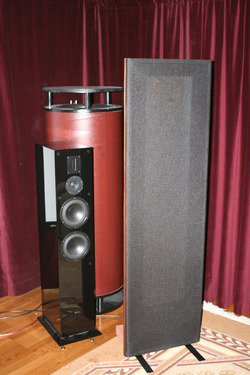January 26, 2010
Magnepan 1.6
While visiting various audio boutique shops a while back, originally to audition some amplifiers, I happened across a stellar setup at Audible Arts. A large room with decent acoustics was running a pair of Analysis Audio full range ribbons, driven by a VTL TL-7.5 and Spectron Musician III Mk2 amplifier. The Analysis Audio speakers need an amp like the Spectron because their impedance drops so incredibly low. I was using my Neko Audio D100 DAC for the source.
There was a very specific sweet spot, but it sounded amazing. Hearing this setup sold me on full-range planars without an enclosure (i.e. dipole). Not because I wanted the rear wave, but because they are just so quick and the smear goes away. Of course the electronics need to be free of smearing as well, but with planars the whole boxy sound goes away and everything is incredibly crisp and tight.
I have had some experience with ribbon and planar audio technology since I have Onix Reference 3 and Strata Mini speakers. But a real dipole planar was just so much more impressive. I'd originally picked the Reference 3 in part because I wanted a ribbon tweeter, and that was a nice improvement over other tweeters I had heard. But this was no comparison.
I started shopping around to see what sort of planars would work for me, given my budget. I listened to some Martin Logan speakers but was disappointed by the lack of bass control. Except for the CLX, the Martin Logan speakers incorporate a cone driver for the low frequencies. The integration at the crossover point didn't impress me, and I did not hear the tight control I had heard with the Analysis Audio speakers. They were being driven by Pioneer's flagship receiver, so that may have had something to do with it.
 Then I stopped by The New Audible Difference to check out the Magnepan line. I listened to the 12, 1.6, and 3.6. This was a sound that I loved. I decided then and there that this is the speaker I wanted to get. The Magnepan sound quality was very close to the Analysis Audio ribbons, and much more affordable. :) I also felt the Magnepan off-axis behavior was slightly better than the Analysis Audio speakers, which would make things a bit more enjoyable.
Then I stopped by The New Audible Difference to check out the Magnepan line. I listened to the 12, 1.6, and 3.6. This was a sound that I loved. I decided then and there that this is the speaker I wanted to get. The Magnepan sound quality was very close to the Analysis Audio ribbons, and much more affordable. :) I also felt the Magnepan off-axis behavior was slightly better than the Analysis Audio speakers, which would make things a bit more enjoyable.
There was a significant difference between the 12 and 1.6 in large part due to the different height. The 12's made everything sound like they were coming from some point near the floor, while the 1.6 and 3.6 presented a better height. I didn't feel there was much difference between the 1.6 and 3.6, and in truth after speaking to Magnepan I decided I could not run the 3.6 speakers because I would risk damage from my subwoofers.
After setting things up at home, I am extremely happy. As I mentioned earlier, I was not particularly interested in the rear wave acoustic signature, and I like the sound much more without it. So I've placed acoustic panels almost immediately behind them to absorb the rear wave.
I am using the Magnepans with my subwoofers and an 80Hz crossover. The Magnepan speakers won't play very loud due to their low sensitivity and physical limitations, and of course they do not extend as low as my subs. But the integration is extremely good. There's no way I could run Magnepan speakers for home theater, but for music they're absolutely wonderful.
Posted by josuah at January 26, 2010 8:02 AM UTC+00:00
Trackback Pings
TrackBack URL for this entry:
http://www.wesman.net/cgi-bin/mt/mt-tb.cgi/1572

 Nami & Kiba - Away From Home
Nami & Kiba - Away From Home Goodbye Ellie
Goodbye Ellie Evangelion Mini Cooper S Clubman
Evangelion Mini Cooper S Clubman Married to Christina
Married to Christina
Comments
Post a comment
Thanks for signing in, . Now you can comment. (sign out)
(If you haven't left a comment here before, you may need to be approved by the site owner before your comment will appear. Until then, it won't appear on the entry. Thanks for waiting.)